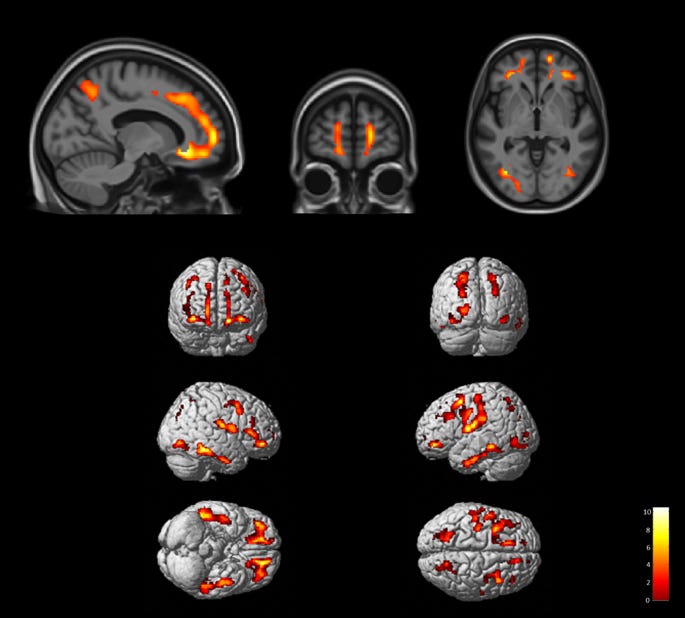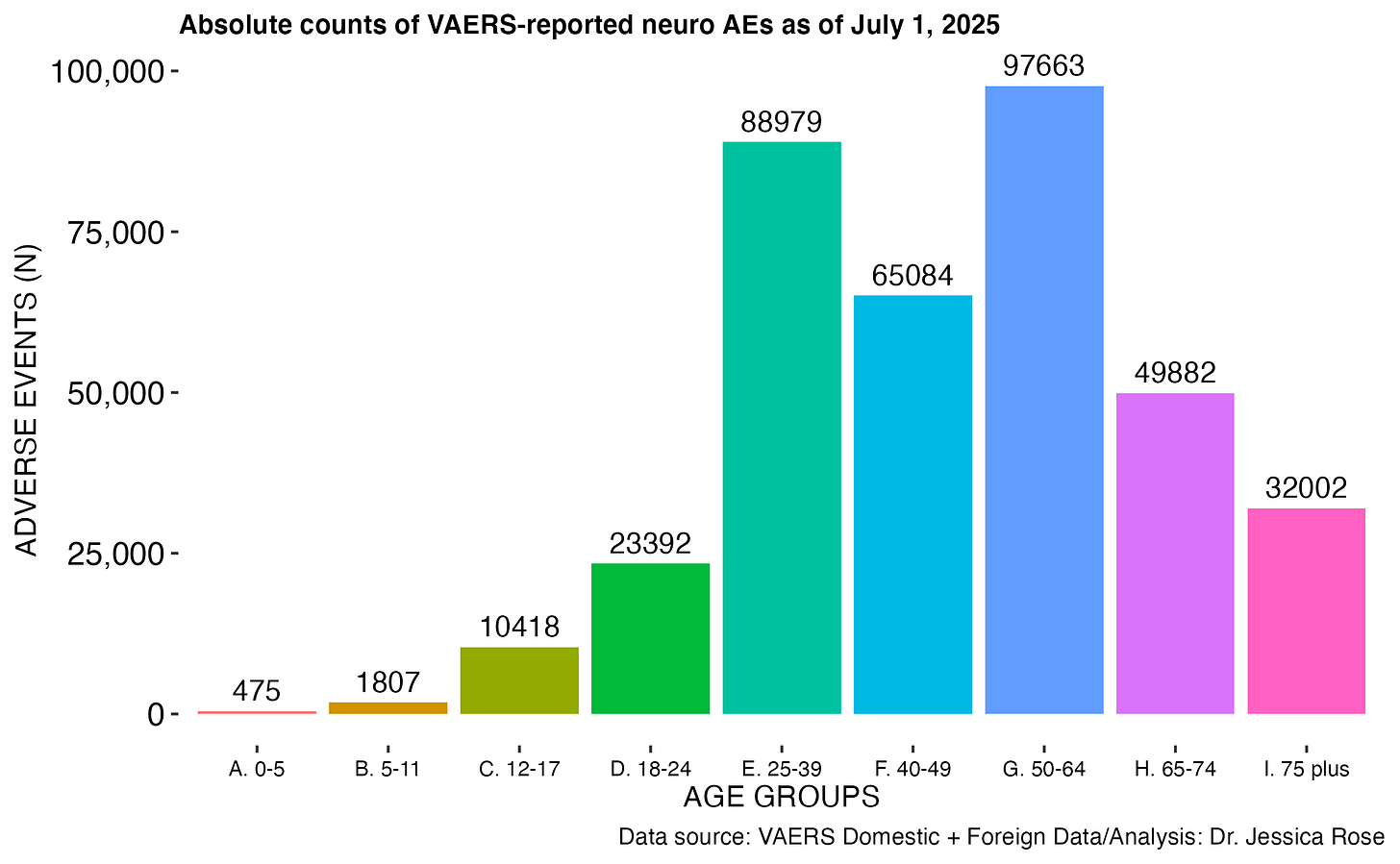This SARS-spike thing they made ruins brains
A new study demonstrates hypometabolism (reduced glucose uptake) in specific areas of the human brain - think reason for brain fog
A new study has been published in Scientific Reports entitled: “Mapping brain changes in post-COVID-19 cognitive decline via FDG PET hypometabolism and EEG slowing”,1 and it lays out a mechanism of action for brain fog/neurodegeneration/cognitive decline and other forms of brain deterioration seen in hundreds of millions of people from being subjected to SARS-2, and I might add, inevitably, from the COVID-19 shots encoding spike protein as well. The reason I say this is that there is no doubt in my mind at this point that the culprit of neuroinflammation and brain pathologies is the spike protein.
Our study aimed to investigate brain functional alterations and the underlying mechanisms using PET and EEG in post-COVID-19 subjects with subjective cognitive decline following mild SARS-CoV-2 infection, compared to healthy controls.
So they found brain functional alterations in people with what they refer to as “mild SARS-CoV-2 infection”.
Fluorodeoxyglucose positron emission tomography (FDG PET) measures brain glucose metabolism to assess function and disease, while electroencephalography (EEG) records electrical brain activity to evaluate neurological conditions. They used both techniques to paint a better picture of the connection between brain electrical activity and cerebral glucose metabolism in the context of brain functional dysfunction.
What they found in the 28 people with cognitive decline (defined as memory deficits, reduced attention, and executive function impairments, as well as fatigue) from SARS-CoV-2 (ahem: spike protein) in comparison with controls (28 people who’d had EEGs prior to the COVID-era with no recorded history of cognitive impairment or any other neurological disorders), was that the test group exhibited significant hypometabolism in particular locations in the brain. They found the largest hypometabolic cluster in the right frontal lobes of test subjects.

The right frontal lobe plays a key role in various human activities and behaviors, primarily those involving executive functions, emotional regulation, and social cognition. So if its damaged, it can lead to impulsivity, poor social judgment, emotional dysregulation, or reduced insight into one's behavior. Interesting.
The left frontal lobes, the temporal lobes and the parietal lobes were also found to exhibit hypometabolism. Wherever you find reduced glucose uptake, you’ll find impaired brain function.
Our study identified a shift in EEG rhythms from higher frequencies, such as alpha, to lower frequencies like theta and delta, particularly in anterior regions, which aligned with the observed hypometabolism clusters.
The shift from alpha to theta/delta EEG rhythms in anterior regions, characterized concurrently with hypometabolism in the frontal, temporal, parietal, and left occipital lobes, suggests neurodegenerative or pathological processes causing cognitive, behavioral, and perceptual deficits.
Sounds a lot like Alzheimer’s (dementia) to me.
The authors also point out this critical point in the Discussion.
Notably, the neurochemical basis of these findings may be linked to disrupted neurotransmitter systems, particularly involving GABAergic and glutamatergic pathways.
Yes. It could be. I believe the mechanism of action here is spike-induced neuroinflammation and vascular damage. On its own, hypometabolism reflects reduced neuronal glucose uptake due to dysfunction or inflammation. The spike protein's inflammatory and immunomodulatory effects are certainly contributing to hypometabolism in these brain regions by disrupting neuronal function and energy metabolism through microglial activation and cytokine release. Among other things.
Now. Think COVID-19 shots. What was the template they insisted on using to encode which protein now to be non-stop produced by people’s own cells? Hmm. Was it something like… spike protein? Or something?
I will leave you guys with a VAERS query of neuroinflammation-related reports. I included some of the symptoms reported in the study above including dizziness and headache.
In addition to cognitive decline, post-COVID-19 symptoms at the time of evaluation included asthenia (46.4%), persistent dyspnea (35.7%), hyposmia (28.6%), headache (25.0%), myalgia/arthralgia (17.9%), hypogeusia (17.9%), dizziness/gait instability (17.9%), palpitations/tachycardia (10.7%), and gastrointestinal distress (10.7%).
The chart below shows only VAERS ‘neuro’ reports (absolute counts by age group) that got to the front-end system. This is the tip of the iceberg - a representation of the 467,754 neuro reports in VAERS - based on those with age-data, and those reports that ‘got in’ and not subsequently removed. And this is ONLY in the COVID-19 shot context.
What do you think? Is spike ruining our brains? I think it is. It’s doing more than that though, don’t forget, but the brain is kind of important.
Manganotti, P., Iscra, K., Furlanis, G. et al. Mapping brain changes in post-COVID-19 cognitive decline via FDG PET hypometabolism and EEG slowing. Sci Rep 15, 23141 (2025). https://doi.org/10.1038/s41598-025-04815-6





But this was at the beginning of the vax rollout and from a quick glance, they appear not to have screened for jabbed or unjabbed.
Mitochondrial dysfunction will affect the brain first, each brain cell holds many thousand mitochondria, and if the electron transport chain is functioning poorly the energy output will suffer and cognitive impairment follows.
Has any of your boffin friends found evidence of microplastic/amyloidosis/synthetic protein fusing together to make parts of the brain lose nutrient supply?
The human form knows how to break down animal and plant proteins via the protease from the pancreas, but I am certain when it comes to plastics and synthetic spike protein, it cannot break things down into amino acids.
New data suggests serrapeptase can dissolve polyester part of the plastics problem, nattokinase can dissolve fibrin, and augmented NAC can break up disulphide bonds.. maybe start using proteolytic enzymes to lower the spike and fibrin load and NAC to help the liver clear the debris..it’s all we seem to have right now.
Just a thought!